The Huawei Ascend Mate 7 Review
by Andrei Frumusanu on December 2, 2014 8:00 AM EST- Posted in
- Smartphones
- Huawei
- Mobile
- Ascend Mate 7
- HiSilicon
CPU Performance
Let's a better look at the Kirin 925's performance in terms CPU power. Again, this SoC is merely a slightly higher clocked Hi3630 as we've already benchmarked on the Huawei Honor 6. The basic hardware remains the same - a 1.8GHz quad A15 cluster with 2MB of L2 and a 1.3GHz quad A7 cluster with 512kB of L2 cache. The setup is running on an HMP (Heterogeneous Multi-Processing) hardware implementation running on a Linaro GTS (Global Task Scheduling) software stack on the Linux kernel. Memory is provided by 2GB of LPDDR3-1600 memory in this unit, with a higher 3GB variant available.
First, we take a look at our browser suites, testing general Javascript performance inside Chrome.
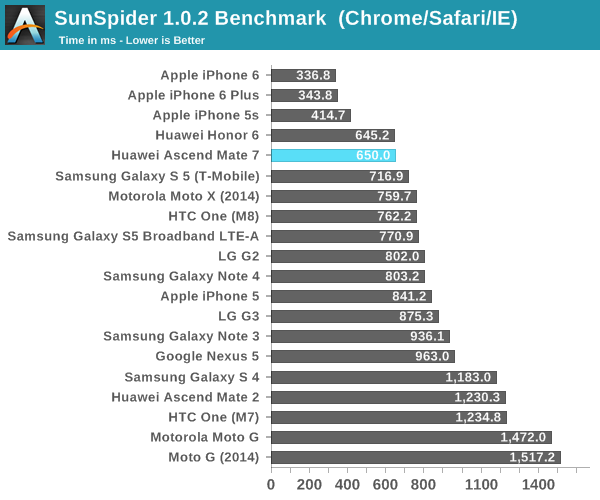
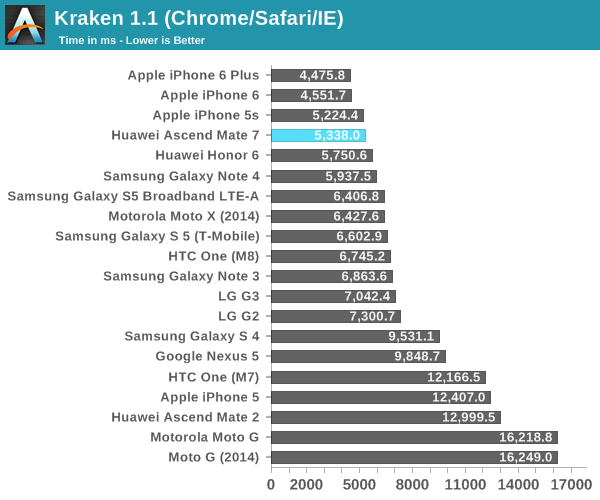
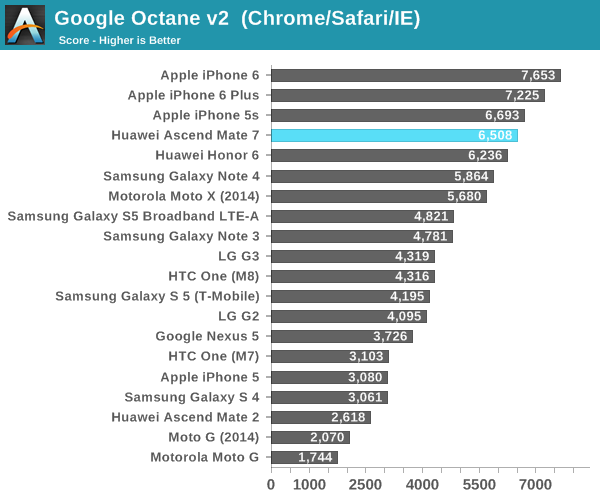
As expected, the Mate 7 doesn't differ too much from the Honor 6. The slight 100MHz boost on the A15 cluster brings it a few slight percentages above the Kirin 920. Again we see the big.LITTLE configuration and the A15 in general being extremely well-performing in these tests, being at the forefront of Android performance and only being beaten by Apple's own chip architectures. It's safe to say that the CPU has no issues at all in delivering an excellent and fast web-browsing experience.
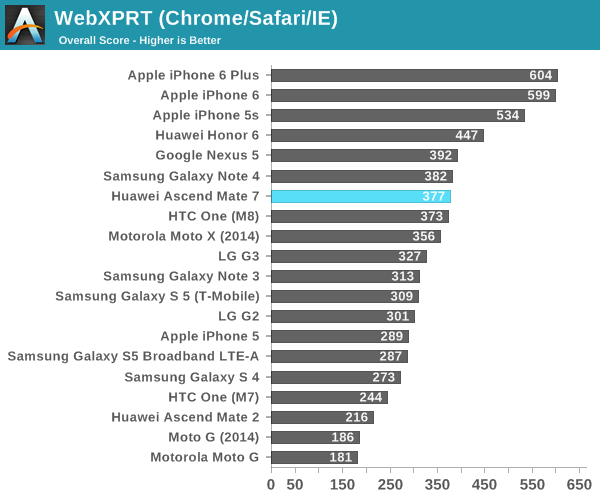
WebXPRT has behaved weirdly on the Mate 7, it consistently scores less than the Honor 6 even although they employ the same chip. I'm not too sure as why this happened. My assumption is that there might be some software regressions in Huawei's OS libraries, but it's weird to see WebXPRT being the sole test unit to suffer from this effect. Because the CPU is running at a higher clock and voltage, we might be seeing some problem with throttling as WebXPRT tends to run much longer than the previous benchmarks.
Let's continue on with BaseMark OS II, a benchmark which tries to measure several aspects of a system.
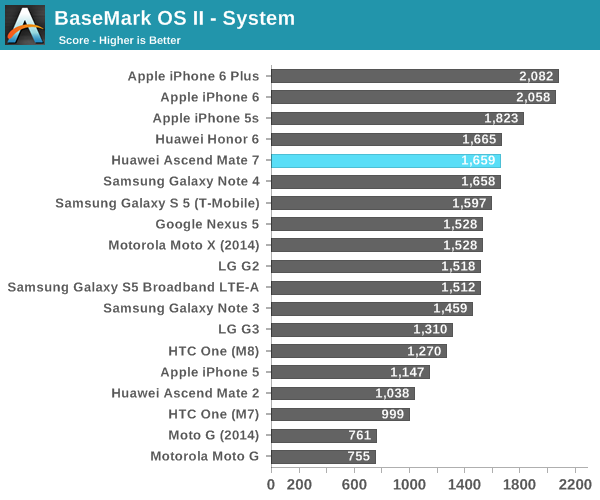
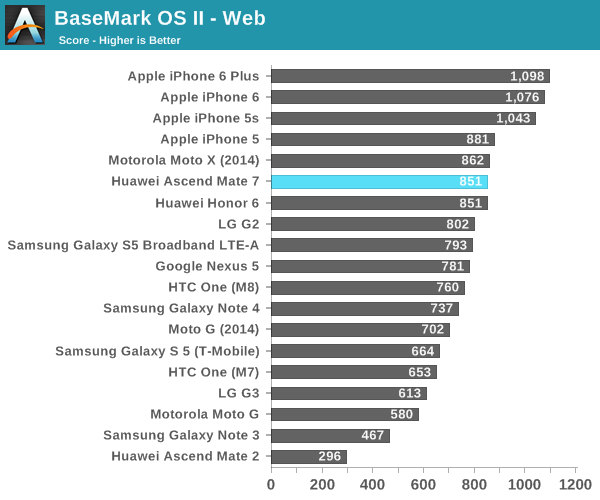
The System and Web tests in BaseMark are mainly CPU limited. We see a similar ordering as in the Javascript benchmarks, with the Kirin leading the Android devices behind Apple's iPhones.
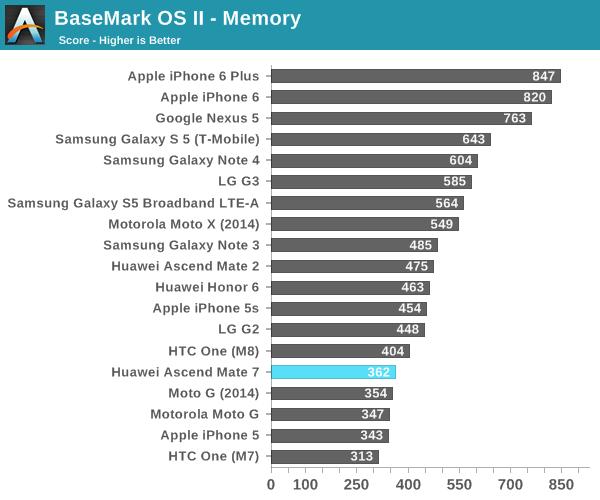
The memory benchmark is performing very weakly here. As a reminder, BaseMark is also testing the NAND performance in the memory sub-test, and not the main memory.
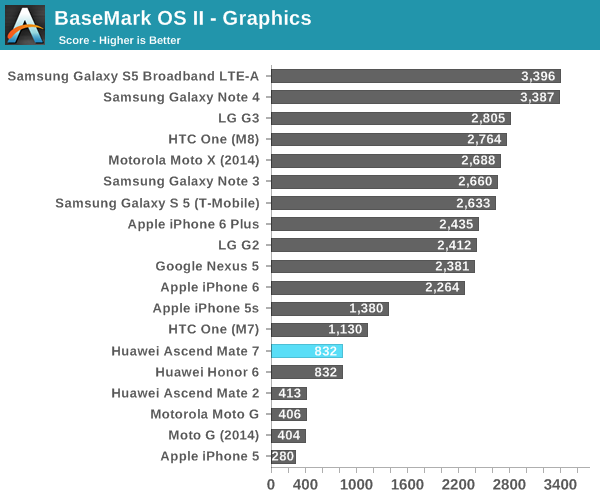
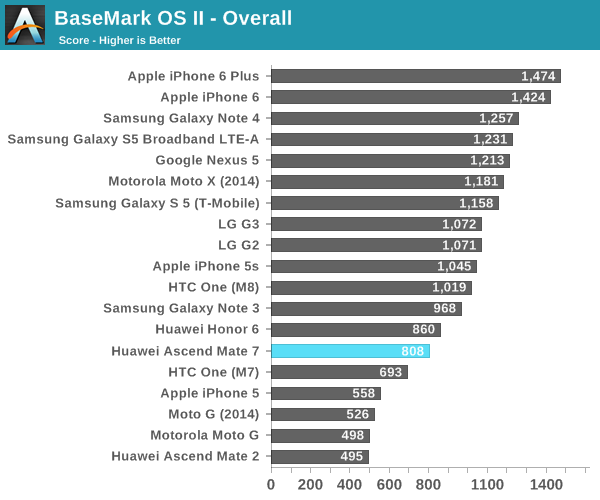
Like on the Honor 6, the Mali is having big issues with BaseMark OS II's Graphics benchmark and ends up below even Qualcomm's last generation's GPU. This, in conjunction with the lower memory score brings the overall BaseMark score further down.
Again the Mate 7 performed worse than the Honor 6. We're starting to see a trend here where longer lasting performance tests perform worse on the Mate 7, again I suspect a throttling issue here. Before we dwell more deeply into that, let's revise the performance of the Mali T628MP4 again.










72 Comments
View All Comments
Lwazis - Monday, September 21, 2015 - link
Awesome phone, awesome battery life, fast processor especially in gaming. great screen, a bit low on brightness but not too bad. 6" feels good on one hand use that you actually forget it's that big. Fingerprint scanner is great, works very well. The camera is really good, surprisingly so.While software is eye candy (which i personally am a fan of) and offers more functionality than standard Android (A lot of functionality, the little things that make it a joy to use), it is a bit buggy. EMUI 3.0 looks good, like a cross breed between iOS and Android and i love that, however, it tends to reset to default settings on some applications kinda like forcing you to stick with EMUI's default apps, like the launcher, Messaging app, phone app, music app, etc. (this can be really annoying at times, but it is controllable).
Another thing is, and this is really strange, EMUI doesn't allow other 3rd party apps to gain access to the phone's "notification access", e.g. lockscreen apps. the functionality simply doesn't work, so you end up being forced to use only EMUI's native lockcreen, which by the way is the only lockscreen that works with the fingerprint scanner, meaning if other 3rd party lockscreen apps could actually work, they’d still not work with the fingerprint scanner. make sense?
So to sum it all up... phone hardware is superb and the internals are beastly too, especially battery life, in fact best in class. It also feels and looks expensive and premium. software is a joy to look at, really eye-candy, the little things like installing apk's, checking for software updates, the shutdown screen, all look visually pleasing, even uninstalling a app looks and feels like a beautiful process. However, if you like to customise Android, then the software experience could prove to be a little bit frustrating but nothing over the edge. And since it’s software, Huawei can fix it with an update. This is a good phone.
Jay Park - Sunday, December 20, 2015 - link
I'm a big advocate of Samsung Note series. However I have been using Mate 7 since the first launch...because the price was much cheaper, and I found the specs to be better (160GB, sensors, larger screen, brighter screen and a more intuitive UI) and have been using it to test games. So far I am impressed by the solid build, as I have dropped the phone many times and the screen barely has a scratch. Small dents in the frame but none too noticeable. It's been a year, and I find the phone to have been quite stable. I look forward to the next series.